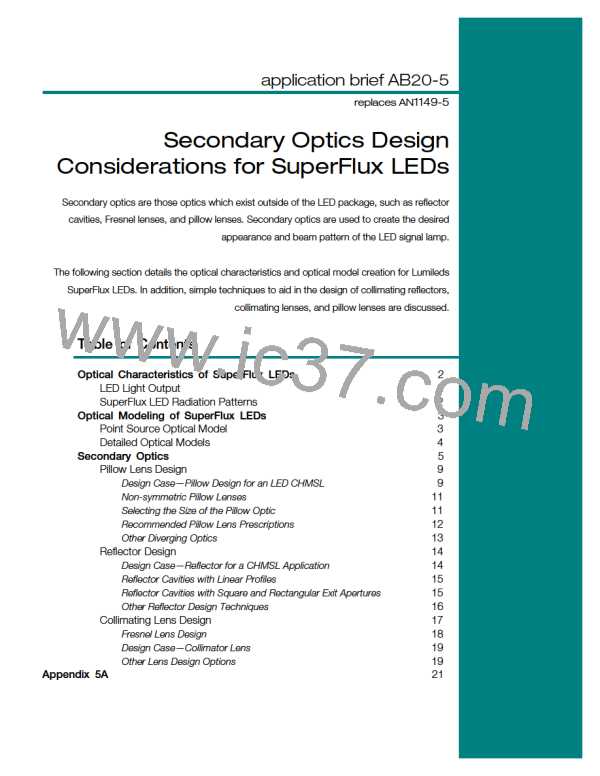Design Case—Collimator Lens
Consider the case where a lens will be used to collimate the
light from an HPWT-DH00 source, and a pillow optic cover
lens will be used to form the final radiation pattern. Clear
PMMA (n = 1.49) will be used as the lens material. The LED
spacing is 20 mm and the spacing from the top of the PCB
to the top surface of the lens must be less than 25 mm.
The total included angle of the HPWT-DH00 is 70°,
therefore, to capture 90% of the light from the LED, the lens
must span 35°?from the optical axis, and fill a 20 mm X 20
mm area. The combination of included angle, lamp depth,
and LED spacing define the necessary items to determine f.
Figure 5.30 shows a cross-section of the lamp described
above.
To optimize collection efficiency, R1 must be greater than R2.
By placing the flatter surface closer to the LED, the ray
bending is more equally shared between the two lens surfaces.
However, if R2 becomes too small, the lens will be too thick
and difficult to manufacture. A good compromise between
these two competing factors is R1 = 24 mm, and R2 = 18 mm.
Figure 5.31 shows a cross-section of an LED signal lamp with
this dual-convex lens design.
Examining the geometry shown in Figure 5.30, the desired
focal length, f, is approximately 15.3mm. A lens of this
power will be a dual-convex, and R1 and R2 can now be
calculated using the following equation:
Consider a case with a plano-convex lens (R =
19mm) where an aperture diameter of 25 mm
is desired for use as a collimating lens. This lens
will be too thick to properly injection mold
(greater than 6 mm), so a Fresnel design will be
used with a maximum height of 4 mm. The
resulting design will have three steps, as shown
in Figure 5.32.
efficient than spherical forms. However, the
design of these types of lenses is more complex
and generally requires optical modeling software
and accurate optical models of the LED.
Another class of lens exists which couple the
principles of refraction and total internal reflection
(TIR). These lenses are commonly referred to as
reflective/refractive, or catadioptric lenses. Lenses
designed by Fresnel over 100 years ago for light
houses contained such TIR faces for improved
efficiency. An example of a catadioptric lens is
shown in Figure 5.34.
Convex-Fresnel lenses can be designed in
which a large radius (low curvature) lens is used
on the LED side, and a Fresnel-type lens with a
smaller radius (more curvature) is used on the
other side as shown in Figure 5.33.
This type of lens is useful when refractive lens
designs cannot efficiently bend the light rays at
the required angle. By combining reflection and
refraction into a single optical element, a very
powerful and efficient lens can be designed. TIR
is most efficient when incident rays are nearly
tangential, where as refraction is most efficient
when the rays are close to the normal.
Other Lens Design Options
In this section we have discussed only spherical
lens designs. Spherical lenses are easily
designed, specified, and checked; but may not
be the most efficient collimator due to spherical
aberrations. Other lens designs, such as
hyperbolic-planar, sphero-elliptic, and free-form
lenses can be designed which may be more
19

 LUMILEDS [ LUMILEDS LIGHTING COMPANY ]
LUMILEDS [ LUMILEDS LIGHTING COMPANY ]